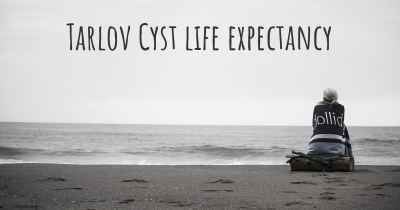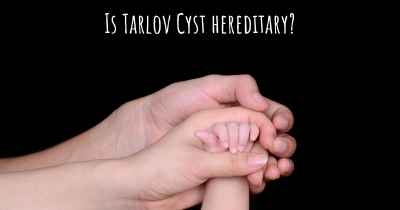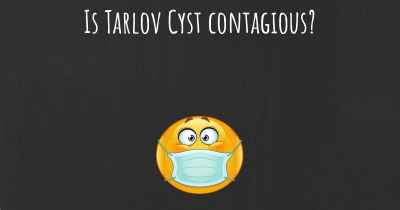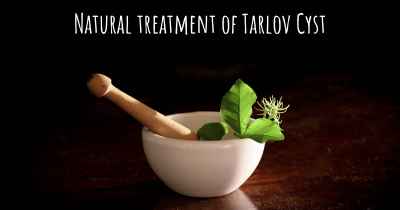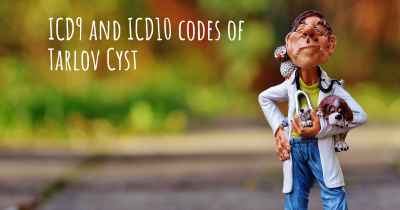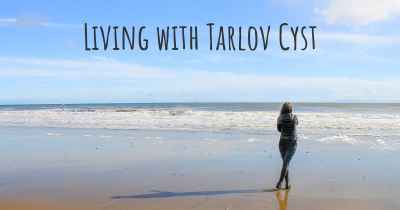Which are the symptoms of Tarlov Cyst?
See the worst symptoms of affected by Tarlov Cyst here
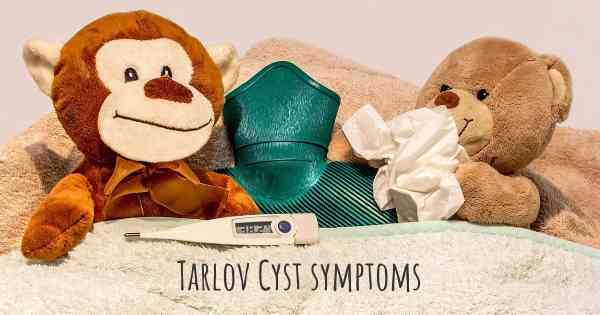
Symptoms of Tarlov Cyst
Tarlov cysts, also known as perineural cysts, are fluid-filled sacs that develop on the nerve roots at the base of the spine. These cysts are typically found in the sacral region, which is the lower part of the spine near the tailbone. While many individuals with Tarlov cysts may remain asymptomatic, some may experience a range of symptoms that can vary in severity.
1. Pain: One of the most common symptoms associated with Tarlov cysts is chronic pain. The pain can be localized to the lower back, buttocks, or pelvic region. It may also radiate down the legs, resembling sciatica. The intensity of the pain can range from mild to severe and may worsen with prolonged sitting, standing, or physical activity.
2. Sensory disturbances: Tarlov cysts can cause sensory abnormalities in the affected area. Patients may experience numbness, tingling, or a pins-and-needles sensation in the lower back, buttocks, or legs. These sensations may be intermittent or constant, and they can significantly impact daily activities and quality of life.
3. Bladder and bowel dysfunction: In some cases, Tarlov cysts can compress the nerves responsible for controlling bladder and bowel function. This can lead to urinary incontinence, difficulty emptying the bladder completely, or bowel incontinence. These symptoms can be distressing and may require medical intervention.
4. Sexual dysfunction: Tarlov cysts can also affect sexual function. Both men and women may experience decreased libido, erectile dysfunction, or difficulty achieving orgasm. These symptoms can have a significant impact on personal relationships and overall well-being.
5. Weakness and muscle atrophy: As Tarlov cysts grow and compress the nerve roots, they can lead to muscle weakness and atrophy in the lower extremities. Patients may notice difficulty walking, decreased muscle strength, or a loss of coordination. These physical impairments can limit mobility and independence.
6. Radicular pain: Radicular pain refers to pain that radiates along the path of a nerve. Tarlov cysts can cause radicular pain that travels from the lower back or buttocks down the legs. This pain may be sharp, shooting, or burning in nature and can be accompanied by muscle spasms.
7. Headaches: In some cases, Tarlov cysts located in the sacral region can cause headaches. These headaches may be localized to the back of the head or neck and can be accompanied by neck stiffness or pain.
8. Other symptoms: Additional symptoms associated with Tarlov cysts may include fatigue, difficulty sleeping, depression, and anxiety. These symptoms can be secondary to the chronic pain and physical limitations caused by the cysts.
If you suspect you may have Tarlov cysts or are experiencing any of the aforementioned symptoms, it is important to consult with a healthcare professional for an accurate diagnosis and appropriate treatment plan. Treatment options for Tarlov cysts may include conservative measures such as pain management, physical therapy, and lifestyle modifications. In some cases, surgical intervention may be necessary to alleviate symptoms and prevent further nerve damage.
Posted Jul 23, 2021 by Stichting Overdruksyndroom NL
Weakness of muscles.
Difficulty sitting for prolonged periods.
Loss of sensation on the skin.
Loss of reflexes.
Changes in bowel function, such as constipation.
Posted May 19, 2022 by AIMIS Spine
- Piercing nerve pains that shoot from sacrum down leg, and no pain killer can touch it as its neurological
- Inability to sit or stand for more than 30 minutes at a time (makes working very difficult when you have meetings), and never being comfortable when vertical as sitting felt like a sharp rock is under you, and standing radiates leg pain. Only lying on my side with a pillow between my legs gave any relief.
- Sharp pelvic pains that made intimacy very difficult
There are many other symptoms such as incontinence and constipation which I did not have, but would be very limiting to daily life. Other symptoms were somehow livable.
Posted Feb 26, 2017 by Amie 1250
Posted Apr 11, 2017 by Kelly 5450
Posted Aug 13, 2017 by James 950
Posted Oct 5, 2017 by Val0920 700
Posted Oct 29, 2017 by Karen 2500
Weakness of muscles
Difficulty sitting for prolonged periods
Loss of sensation on the skin
Loss of reflexes
Changes in bowel function, such as constipation
Changes in bladder function, including increased frequency or incontinence
Changes in sexual function
Posted Jan 20, 2018 by dhedge42 2500
Posted Jun 18, 2018 by MissLeanneM 1700
Posted Jun 18, 2018 by Ze 2520
Posted Jun 19, 2018 by Debbie Dronfield 2500
Posted Jun 19, 2018 by Lynn 2500
Back pain
pins and needles in the legs and feet
cramps in legs and feet
Posted Jun 22, 2018 by Julie 1600
Weakness of muscles.
Difficulty sitting for prolonged periods.
Loss of sensation on the skin.
Loss of reflexes.
Changes in bowel function, such as constipation.
Posted Nov 30, 2018 by Connie 1740
Posted Jan 25, 2019 by Roy DeWyatt Smith 700
Posted Dec 9, 2019 by Ze 1500
Posted Dec 9, 2019 by Jess Carhart 2500
Posted Dec 15, 2019 by Pam 1700
Posted Dec 29, 2019 by Ana José 200
Hip pain
Urinary issues
Posted Jul 22, 2021 by Michelle Tamplin 2500
Numb pain & sharp pain
Pins and needles
Posted Jul 22, 2021 by [email protected] 700
Бих се отървала от парастезиите и изгарящите болки.
Posted Jul 23, 2021 by Моника 800
increasing pain when sitting and standing, increasing pain with walking, valsalva increases pain, exercise increases pain, leg restless, persistent genital agitation (PGAD), increasing pain when sitting and standing, weakness in legs/feet, increasing pain with walking, valsalva increases pain, exercise increases pain, restless legs, persistent genital arousal syndrome (PGAD), significant neck/arm pain, headache (hypertension headache/hypotension headache).
The increased/disturbed pressure of the cerebrospinal fluid in the spinal canal and brain causes these extensive symptoms.
See als in this article from 2017: Electromyography and a literature review provides insight into the role of sacral perineural cysts in unexplained chronic pelvic, perineal and leg pain syndromes
After needle EMG, abnormalities in multiple lumbo-sacral nerve root myotomes were noted in all patients and these abnormalities were bilateral in 80% of patients. In 25 (83%) patients, the pain was in two or more dermatomes at the same time. Only 17 (57%) patients mainly complained of pain in one leg. Ten (59%) of these 17 patients had the greatest TC on the same side as the most severe pain. In 15 of the 17 (88%) patients, the most severe EMG abnormalities were found in the most painful leg. In all patients, TC and/or nerve root dilatations were found on all nerve roots of the painful dermatomes.
Three patients with symptomatic sacral TCs and EMG abnormalities in the sacral nerve root myotomes also had severe thoracic pain in a dermatomal pattern. Therefore, an EMG of the thoracic paraspinals was performed and in these cases EMG abnormalities were detected in the corresponding dermatomes. The MRIs showed nerve root dilatations in the corresponding nerves and the nerve root fibers were widened.
In this study, patients with sacral TCs often complained of neck pain. An MRI of the cervico-dorsal spine was therefore assessed, if available. Because the headaches commonly reported in our patient group may reflect an increase in pressure in the brain tract.
This study explored symptomatic Tarlov Cyst pathogenesis and identified the typical patterns of symptoms caused by STCs, the literature from 1955 through 2016 was searched for relevant assessments and case reports on patients with TCs.
Needle EMG/NCS conduction tests is a less invasive way to diagnose symptomatic Tarlov cysts.
Posted Jul 25, 2021 by SOSNL 2500
Idiopathisch cerebrospinaal drukdysregulatiesyndroom (overdruksyndroom)
Door een gestoorde drukregeling in de hersenen en het ruggenmerg kan de druk in het ruggenmergkanaal oplopen en kan ruggenmergvocht in de zenuwen worden geperst. Deze verhoogde druk leidt tot irritatie van de zenuwvezeltjes met in eerste instantie pijn en tintelingen /slapte /slapend gevoel tot gevolg. De isolatielaag rond de zenuw kan vervolgens uitzetten op een plaats waar ze het zwakst is. Dit gebeurt vooral in het heiligbeen, waar de druk het hoogst is omdat we rechtop lopen en veel zitten. Maar niet alleen daar, ook in de lage rug, de bovenrug, de nek en t.h.v. de hersenzenuwen.
De verhoogde druk veroorzaakt over het gehele ruggenmergkanaal pijnklachten in het bekken, de benen, de voeten, de romp, de nek, de armen, het gelaat, de hals en het hoofd.
Omdat de eerste symptomen enkel pijn en /of tinteling, een slap gevoel en slapend gevoel in ledematen zijn en dit niet te meten is, kan de diagnose niet of laat worden gesteld. Er wordt dan verondersteld dat niet de cysten, maar de artrosetekens die men op de MRI ziet, verminderde fysieke conditie en/of psychologische factoren verantwoordelijk zijn voor de pijn.
Mogelijke symptomen door overdruk in ruggenmerg en zenuwwortels
* Veel patiënten hebben al op jonge leeftijd last van onverklaarbare of ernstige hoofdpijn, rugpijn of buikpijn.
- De meest voorkomende symptomen zijn die van een chronisch cauda equina syndroom aangezien altijd meerdere zenuwwortels in het heiligbeen links en rechts onder druk komen te staan.
- lage rugpijn en/of pijn in het heiligbeen, kan in opstoten optreden (‘acute blokkage’)
- uitstralende pijn in het been
- pijn rond de heup
- pijn in de bilspier
- de pijn neemt typisch toe bij zitten
- krampen in de benen
- zwaktegevoel in de benen (niet goed meer recht kunnen na hurken)
- rusteloze benen
- pijnscheuten (vooral in het heiligbeen)
- pijnlijke en/of slapende voeten, krampen in de voeten, ‘bekneld’ gevoel van de voeten in de schoenen, koude voeten
- de patiënt kan niet meer snel wandelen of niet bergop wandelen zonder pijn, significant tragere wandelsnelheid, soms wat gestoorde gang waardoor tegen mensen en dingen aanbotsen of tegen degene die meewandelt
- pijn en slap gevoel rond de anus, de bilnaad en de geslachtsdelen, pijn bij betrekkingen, pijn vaginaal, t.h.v. de teelbal of de penis
- overgevoeligheid van de huid van de buik, het bekken en de schaamstreek, waardoor ondergoed of strakkere kleding niet wordt verdragen
- blaasproblemen: niet onmiddellijk kunnen beginnen plassen, de blaas niet volledig leeg kunnen plassen, moeten meepersen om de blaas te ledigen, geprikkelde blaas met voortdurende drukgevoel op de blaas, vaak moeten plassen, gevoel van hoogdringendheid, pijnlijke blaas, niet goed meer voelen of de blaas vol is
- darmsymptomen: constipatie, afgewisseld met diarree, buikkrampen, hoogdringendheid, ...
- sluitspierproblemen met meestal lichte incontinentie voor urine en stoelgang, ‘veel toiletpapier nodig hebben om zich schoon te maken’, pijn, steken, drukgevoel of krampen in de anus
- potentiestoornissen, moeilijk tot orgasme komen
- pijn in de nek en arm(en), slapende hand(en), ‘tenniselleboog’, krachteloosheid in de armen, koude handen
- tussenribpijn, pijn op de borst (door uitstraling naar voor), ‘syndroom van Tietze’
- Niet (of niet te lang) kunnen zitten en/of staan
- Pijn toename bij lichamelijke inspanning welke verminderd bij liggen
- fysiek belastend werk en sporten is niet meer mogelijk
- Bekkeninstabiliteit
Bovendien kan ook overdruk in de hersenzenuwen ontstaan
- Dubbelzien, pijn aan de ogen, of pijn aan de oogspieren bij oogbewegingen
- Trigeminusneuralgie, gelaatspijn, tintelingen of voosheid in het gezicht, kaakpijn, gespannen kaakspieren, tandklemmen
- Duizeligheid, draaierig.
- Gestoorde smaak, speekselvloed of droge mond (dorst)
- Heesheid, moeite met slikken
- Moeilijk te behandelen hoofdpijn
- Oorsuizen, zich verspreken, niet op woorden en namen kunnen komen, de draad verliezen, lichte geheugenstoornissen, …
- Op de voorgrond staande vermoeidheid
De klachten ontstaan of verergeren vaak na een trauma en/of tijdens de zwangerschap. (Bekkeninstabiliteit).
Klachten ontstaan geleidelijk of heel acuut, komen en gaan en verschillen in lokalisatie en intensiteit van de ene patiënt tot de andere, maar kunnen in sommige gevallen zo invaliderend zijn dat de patiënt aan huis of bed gebonden is
Posted Jul 26, 2021 by Founder SOSNL 2500
Posted Jul 26, 2021 by KetoGma 2500
- The most common symptoms are those of a chronic cauda equina syndrome, since several nerve roots in the left and right sacrum are always under pressure.
- low back pain and/or pain in the sacrum, may occur in flare-ups (‘acute blockage’)
- radiating pain in the leg
- pain around the hip
- pain in the buttock muscle
- pain typically increases with sitting
- leg cramps
- feeling of weakness in the legs (not being able to straighten properly after squatting)
- restless legs
- shooting pains (especially in the sacrum)
- sore and/or sleeping feet, cramps in the feet, feeling of pinching in the feet in the shoes, cold feet
- the patient can no longer walk quickly or walk uphill without pain, significantly slower walking speed, sometimes somewhat disturbed gait causing bumping into people and things or the person walking along
- pain and limp feeling around the anus, the buttocks and the genitals, pain during intercourse, pain vaginal, at the center of the testicle or the penis
- hypersensitivity of the skin of the abdomen, pelvis and pubic area, as a result of which underwear or tighter clothing is not tolerated
- bladder problems: unable to start urinating immediately, not being able to urinate completely, having to push to empty the bladder, irritated bladder with constant pressure on the bladder, frequent urination, feeling of urgency, painful bladder, feeling unwell or the bladder is full
- intestinal symptoms: constipation, alternating with diarrhoea, abdominal cramps, urgency, ...
- sphincter problems with usually mild incontinence for urine and bowel movements, 'need a lot of toilet paper to clean yourself', pain, stinging, feeling of pressure or cramps in the anus
- potency disorders, difficulty reaching orgasm
- pain in the neck and arm(s), sleeping hand(s), "tennis elbow", weakness in the arms, cold hands
- rib pain, chest pain (due to radiation to the front), Tietze's syndrome
- Not being able to sit and/or stand (or not for too long)
- Pain increase with physical exertion which is reduced when lying dow
- physically demanding work and sports are no longer possible
- Pelvic instability
Double vision, eye pain, or eye muscle pain with eye movement
- Trigeminal neuralgia, facial pain, tingling or numbness of the face, jaw pain, tense jaw muscles, tooth clenching
- Dizziness, vertigo.
- Impaired taste, salivation or dry mouth (thirst)
- Hoarseness, difficulty swallowing
- Hard-to-treat headaches
- Ringing in the ears, making a mistake, not being able to come up with words and names, losing the thread, mild memory disorders, ...
- Prominent fatigue
Posted Oct 27, 2021 by Reinette 400
Posted Oct 25, 2022 by Tania 2500
Posted Mar 24, 2017 by Simona 1060
Posted Jul 26, 2017 by Maria 1220
Posted Oct 24, 2017 by Emy 100
